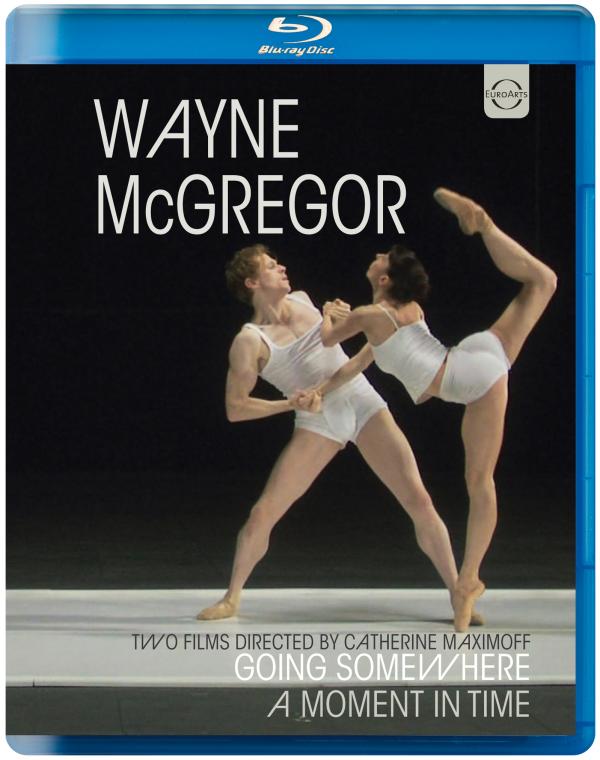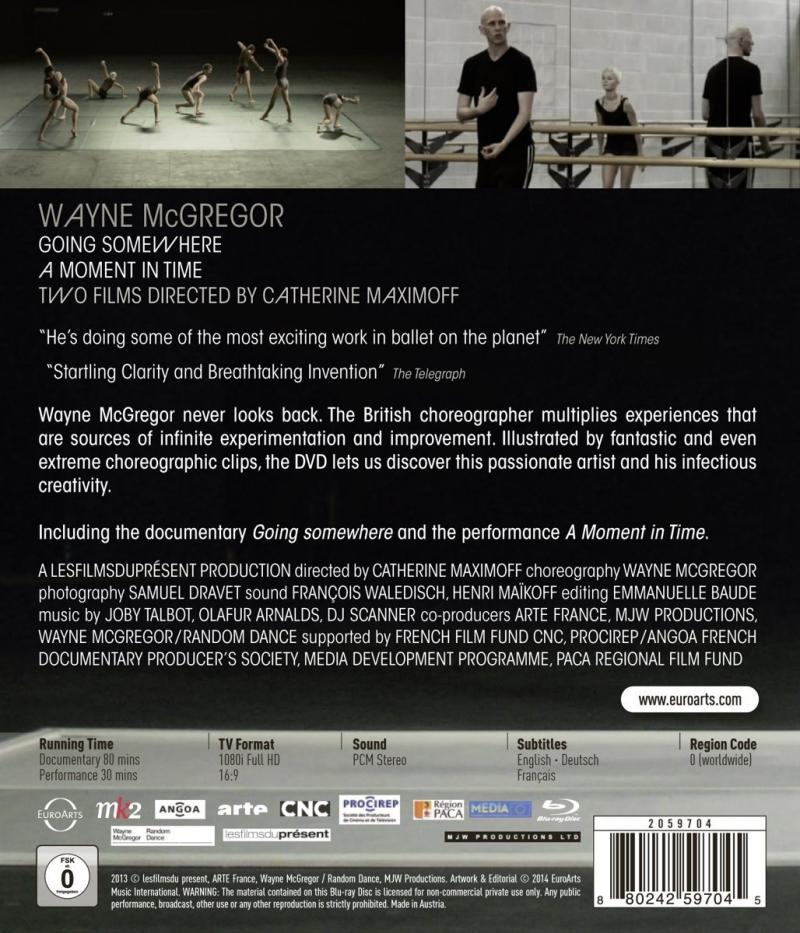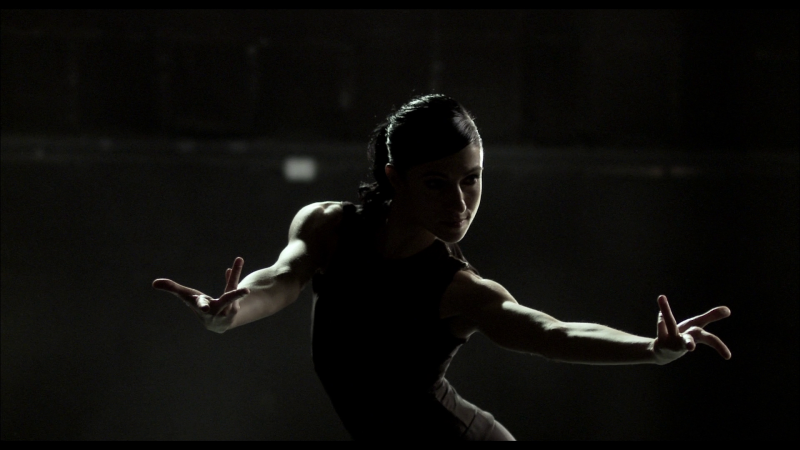

This title includes two films relating to Wayne McGregor:
Going Somewhere is an 80-minute documentary about McGregor as choreographer, and it is reviewed here.
A Moment in Time is a 30-minute performance film, offered as a bonus extra, with three short pieces by McGregor. It has nice music from folks like Joby Talbot, Olafur Arnalds, and Kaija Saariaho. But it will not be reviewed because it only has stereo sound and VHS or DVD-level images.
Going Somewhere considers the choreographic techniques of Wayne McGregor illustrated by recordings of his work with his Random Dance group. There are also recordings of his work with stars of the Royal Ballet, experimental work with high school students, and several "science" segments. Directed for TV by Catherine Maximoff; photography by Samuel Dravet; sound by François Waledisch and Henri Maïkoff; editing by Emmanuelle Baude. Released 2014, disc has PCM stereo sound. Grade: D+
Here's a better view of the 8 members of Random Dance as seen on the back of the keepcase. The dancers, unfortunately not identified individually on the disc, are: Neil Fleming Brown, Catarina Carvalho, Agnès López Rio, Paolo Mangiola, Anna Nowak, Maxime Thomas, Antoine Vereecken, and Jessica Wright:
My favorite image from Going Somewhere. This makes for a nice PC wallpaper:
McGregor is now one of the hottest choreographers in the world. He appears briefly in the HDVD title La Dance (at 20:25). He also speaks in the introductions to his Croma, Infra, and Limen dance pieces released in the Three Ballets by Wayne McGregor HDVD. McGregor leaves an indelible impression as an unforgettable character. How to describe him? Well, mate an octopus with a featherless chicken. Endow the new creature with a genius for movement, and give it a hot-foot. That would be McGregor.
Everyone has a unique face, voice, finger-prints, etc. And, per McGregor, everyone has a unique movement "signature." The essence of McGregor's movement signature is smooth flexibility. Here he leads the Random Dance in an undulation of the rib-cage that will be the foundation for a piece. Even his own dancers seem to have trouble mimicing this. While working, McGregor is seen constantly in motion showing the dancers what he wants, and sometime he breaks loose into wild improvisations, just for fun:
Here McGregor shows a dancers how to suffocate:
And the result is a catastrophic collapse:
I once learned how to dance salsa. I could do all the basic steps and figures perfectly and knew how to follow the salsa beat. I could dance with every woman at the party. So I was dancing the same way as Petipa's white corps in Swan Lake: every step exactly correct and in unison. The underlying features of McGregor choreography are the direct opposite: McGregor doesn't repeat anything and the only "rhythmic intonation" is smoothness (i.e. the absence of following a beat). All this is explained in the first few seconds of the documentary.
Unfortunately, McGregory is a bit hard to understand during much of the recording, and there are no subtitles in English when English is spoken. I was able to figure out what McGregor is saying at the beginning of the documentary by switching to German subtitles. It was slovenly for the publisher of this title not to provide English subtitles in a recording where there are many people speaking poorly and with strong, bad English accents competing with background noise.
To be fair, there are also several clips where McGregor works as talking head. Then he is reasonably easy to understand. But he does have a strong British accent. If you are not a native English speaker and are used to the American accent, you will likely have trouble following McGregor. If you know German or French, you will probably benefit from the subtitles in those languages.
McGregor explains: "I never know at the beginning how a project will end up looking."
"I follow different directions:"
"And the piece consists of the different decisions I make along the way:"
So McGregor strives not to repeat or follow the beat. He also gives dancers room to contribute, I think. But in his choreography McGregor directs the dancers in specific ways. Once he creates a sequence for the dancers, it's up to them to memorize it for rendition in the performance. We see this process take place in a long clip where McGregor creates a sequence for Mara Galeazzi and Paul Kay.
"Didn't you play Twister as a kid?":
The sequence starts with a bump without a grind:
"Now hold her leg tight."
McGregor works with Mara and Paul on several possible "leg grabs":
And the sequence ends with a passionate embrace. "Great! You have to get the feeling across."
In Going Somewhere, the creation of the "bump to embrace" sequence above is shown in isolation as an example of how McGregor works. But I thought it was familiar. Sure enough, I found it performed by Mara and Paul at 00:16:14 to 00:16:35 in the Limen title from Three Ballets from Wayne McGregor.
Here's the bump in Limen:
Here's the leg grab:
And finally below the the embrace. There are other moves in this segment that I don't show, but when you compare the 2 clips, there's no doubt that 97+ of what you see McGregor create shows up in the performance. I would guess the 3% difference would be improvisation by Mara and Paul. This is probably the only example we have in HD videography of the actual creation of and the later performance of a specific dance segment:
More philosophy from McGregor stating that "Choreography is [therefore] both a mental and physical exertion." McGregor makes a number of other comments about his art, some of which may be things that all choreographers say:
This shot is from a Random Dance duet that illustrates the mental and physical exertions discussed by McGregor. This segment includes a large number of very specific hand and arm movements between the dancers that I've never seen before:
McGregor is interested in the relationship of dance to science and information technology. Here scientists try to “shrink” the dancers by giving them survey questions on paper forms from them to fill out:
"No doubt you have heard of Project R-Research."
"Project R-Rearch is designed to create an intellectual basis for choreographic thinking." The dancers have to be nice about all this, but you know they must have been groaning inside:
McGregor insists that his choreographic approach can be effective with anyone. There are several extensive segments in which Random Dance dancers work with normal high-school students (no prior dance training). Here are two shots from the student performance which justly receives wild applause from the audience of students and parents:
Oh, yes, let's don't forget that short clip of my favorite dance pair: Ed Watson and Mara Galeazzi. Here they perform a smoking duet by McGregor. The only problem is that the videography of this is at the level of a VHS tape with shockingly soft resolution, washed out color, and stereo sound. The clip is shown complete in A Moment in Time, which is excluded from this website. A 2-minute portion of the clip also incorporate into the Going Somewhere documentary. I suspect this was done for the primary purpose of allowing the publisher to put an image from it on the front cover of the keepcase. The image on the cover is vastly better than what you will see on the disc. I can't say it's false advertising, but I will condemn it as gross puffing:
So what grade for this documentary? I already mentioned the weak resolution and washed out color in most of the images. I mentioned poor subtitles. This disc also has the worst motion artefacts I've seen in some 90 Blu-ray dance titles. So the bad video together with no surround sound would render this unmerchantable to the general public and lead to an F grade. Still, I acknowledge that I learned quite a bit from Going Somewhere. I just watched the Three Ballets by Wayne McGregor again; I think I enjoy it more now that I've seen Going Somewhere. There can be a benefit from the documentary for those who have a special interest in McGregor and don't expect much from the title otherwise. On that basis, my grade is D+ or “buy this if you have a special reason.”
OR























